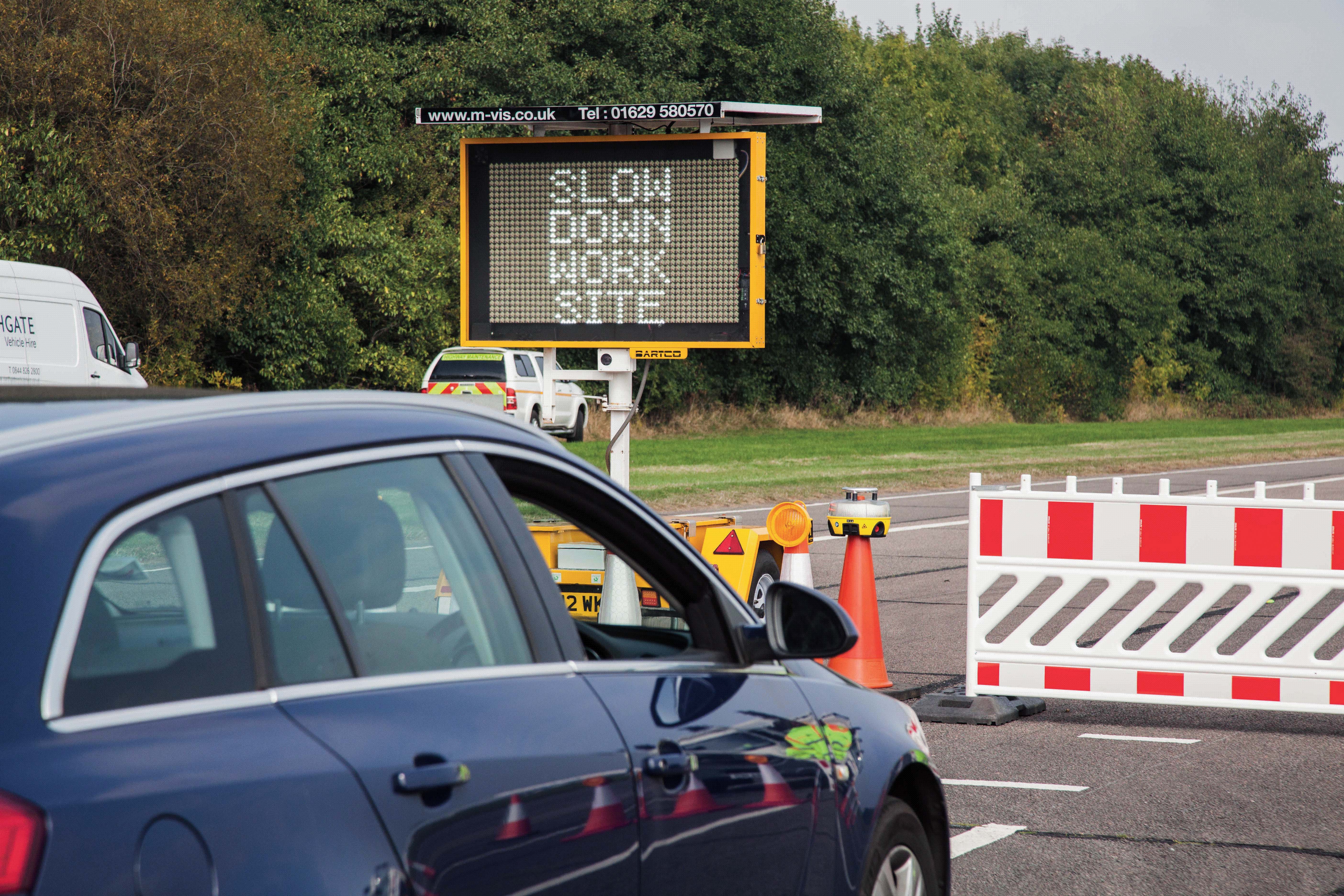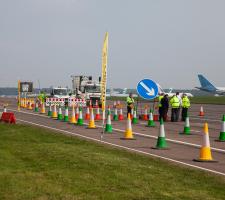
David Crawford looks how workzone safety can be ‘economically viable’.
Highway maintenance is one of the most dangerous construction industry occupations in Europe. Research from The Netherlands on fatal crashes indicates that the risk facing road workzone operatives is ‘significantly higher’ than that for the general construction workforce. A survey carried out by the
The reliance of on soft barriers for guarding temporary workzone, such as traffic cones which need battery-powered lanterns for overnight functioning, has prompted a look at the potential for using this type of power source to drive smarter perimeter protection systems. The ensuing EC-sponsored, 2012-2014
As it has progressed, results have shown the scope for making substantial cost savings in other areas. One is the redeployment of traffic management officers from passive zone perimeter guarding duties (which carry personal risk due to errant drivers) to more productive roles. Another is the prevention of high plant and construction vehicles from striking overhead on-site infrastructure or cabling.
The eight-partner, four-country project held its final test day last month. Events that took place included successful trials of the resistance to vehicle impact of a new smart rechargeable lamp battery; and the demonstration of a Safelane-branded workzone traffic management system.
This has two key elements. The first is the intelligent, battery-powered ‘intellicone’ sensor developed by workzone security specialist Highway Resource Solutions (HRS), the Safelane project leader. This system wirelessly communicates with the second component, a portable variable message sign (VMS) produced by associated mobile visual information developer MVIS. 1:10
Cost saving ratio of new and conventional overhead hazard warning
<18 months
Payback period for new smart batteries replacing currently-used disposables
On detecting a perimeter breach by an errant vehicle, the system’s sensor cone triggers both an audible alarm, within earshot of nearby members of the workforce and a warning ‘STOP’ message to the errant driver on the strategically placed mobile VMS.
It is also possible to link with a camera to record the incident and details of the intruding vehicle for police follow up, if appropriate.
Traffic management officers also carry personal impact alarms, while site supervisors receive warnings by text message. Wirelessly linking a series of cone sensors creates a fully electronically-protected perimeter; while a recently-developed web platform enables two-way communications across the workzone for supporting site management, using data extraction and remote upgrading technology.
A facet of the Safelane system is also emerging as having the collision-reducing potential for alerting oncoming drivers to the presence of a works vehicle that is about to exit from a workzone onto the carriageway.
Further anticipated roles for the VMS include public information. For example, drivers being held in a queue can be told why they are being delayed and advised to switch off their engines, so helping to reduce pollution.
The over-height vehicle application offers an alternative to the conventional use of a pole-mounted beam set at the high of the obstructions that triggers an alarm if the beam is broken by an over-height object. This new approach uses temporary ground-mounted sensor cones to detect and warn all approaching site vehicles, via a plug-in in-cab device, that they are nearing an overhead or any other potential hazard and should therefore drive with care.
Highway Resource Solutions director Roger Poeth told ITS International: “This means that, instead of having to be selective and position overheight sensors at pre-determined strategic locations, site managers can place moveable proximity ‘dangerous area’ alerts near to all potential hazards, which is much simpler.” He estimates the cost savings ratio as being 1:10 in favour of the new system.
Following the September 2014 impact trials TRL and two other partners,
This smart alternative can be contactlessly induction-charged at an on-site unit, incorporates an impact sensor and is designed to work with any lantern lamp.
Work is under way on the commercial roll out and Poeth anticipates strong interest in an “economically viable” alternative to the use of disposable batteries, and indicates a payback period of less than 18 months.
HRS and M-VIS used the test day formally to launch a new technical partnership. Their association has developed from a 2012 request from Costain, which was looking for a more cost-effective overhead strike solution.
The European Union Road Federation (ERF) is addressing a general lack of detailed and widely-sourced information on the issue through its working group on workzone safety, which is due to publish the EU’s first-ever guidelines by end-2014/early 2015. ERF director of public affairs José Diez told ITS International: “The EC publishes data through its Community Road Accident Database, but there is nothing related specifically to workzones”.
CVs at Detroit: expectations and realities
Five special interest sessions orchestrated by the International Benefit, Evaluation and Cost Working Group (IBEC) at the 2014 World Congress examined the potential for connected vehicles (CVs) and attracted unusually wide discussion. According to Martin Böhm,
“Again”, says Böhm, who spoke in a session on CV evaluation, “technicians are no longer reliant on single suppliers; so they can take the next big step by combining different vendors’ equipment and presenting services to end-users via smartphones, navigation devices, tablets or in-vehicle displays. Drivers will choose the interfaces they are used to. All tests and demonstrations clearly show that they [drivers] are primarily interested in qualitative issues such as accuracy and completeness and don’t care too much about the specific device”.
Those at Detroit agreed the technological achievements have exceeded early estimates - the range of dedicated short-range communications (DSRC) roadside units is up to five times greater than original expectations.
While Congress heard a lot about safety, Böhm said: “There seemed to be some reluctance to discuss the implications for CV. It is clear that there will be positive safety impacts, in terms of reduced accidents levels – but these are already falling without any ITS interventions.
“Even through CVs and automated driving could avoid 95% of crashes, system failures and human errors could still cause accidents.”
Expectations of environmental impacts have seen estimates of up to 30% reductions in CO2 emissions, Böhm said: “Such results have not been achieved in any of the demonstrations that we discussed, with emissions savings in single-digit percentages.
But if vehicles were connected Böhm said congestion could fall with improved traffic flows through avoiding stop-and-go driving and shorter gaps between vehicles as well as the maximised use of current road capacity via I2V communications.
It emerged that the economic impact could be the driving force for adopting CV technology. “Most importantly,” said Böhm, “we need to agree on the organisational and institutional frameworks for creating new levels of cooperation and breaking up the silos currently occupied by individual stakeholders.
“Only if we ensure that all the stakeholders involved have clear and commonly agreed responsibilities can we start paving the way for full-scale CV deployment,” he concluded.
https://sites.google.com/site/ibecits
RSS














